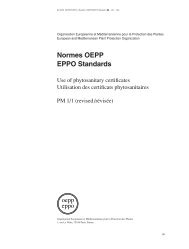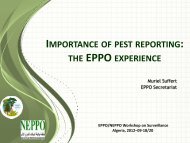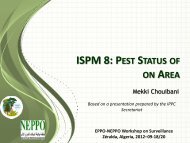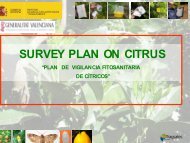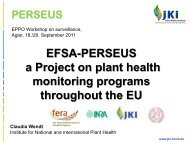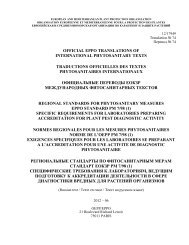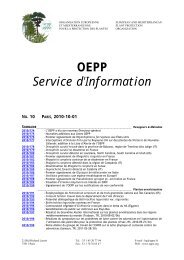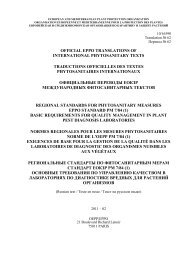EPPO Reporting Service - Lists of EPPO Standards - European and ...
EPPO Reporting Service - Lists of EPPO Standards - European and ...
EPPO Reporting Service - Lists of EPPO Standards - European and ...
Create successful ePaper yourself
Turn your PDF publications into a flip-book with our unique Google optimized e-Paper software.
<strong>EPPO</strong> <strong>Reporting</strong> <strong>Service</strong> – Pests & Diseases<br />
– formerly <strong>EPPO</strong> Alert List), ‘Ca. P. aurantifolia’, ‘Ca. P. solani’ <strong>and</strong> ‘Ca. P. trifolii’ (Zirak<br />
et al., 2009). Present, in the centre <strong>and</strong> south.<br />
Radopholus similis (<strong>EPPO</strong> A2 List) occurs in New Caledonia (Gr<strong>and</strong>ison et al., 2009).<br />
Present, no details.<br />
Xiphinema rivesi (<strong>EPPO</strong> A2 List) occurs in Chile where it was first reported in 2002.<br />
Experiments showed that X. rivesi populations from Chile were able to transmit Tomato<br />
ringspot virus to cucumber test plants (Auger et al., 2009). Present, first found in 2002.<br />
� Detailed records<br />
Frankliniella occidentalis (Thysanoptera: Thripidae – <strong>EPPO</strong> A2 List) occurs in the Azores<br />
(Portugal). It is reported from the isl<strong>and</strong>s <strong>of</strong> Faial, Saõ Jorge <strong>and</strong> Terceira (Borges et al.,<br />
2005).<br />
The presence <strong>of</strong> Globodera pallida (<strong>EPPO</strong> A2 List) in Bulgaria was confirmed in 2006. It is<br />
the prevalent Globodera species in the Smolian region, <strong>and</strong> mixed populations with G.<br />
rostochiensis were found in the regions <strong>of</strong> Blagoevgrad, S<strong>of</strong>ia, Plovdiv, <strong>and</strong> Pazardzik<br />
(Laginova <strong>and</strong> Hristova, 2009).<br />
Halyomorpha halys (Heteroptera: Pentatomidae – <strong>EPPO</strong> Alert List) occurs in Sh<strong>and</strong>ong<br />
province, China (Yang et al., 2009).<br />
Potato purple top disease (<strong>EPPO</strong> A1 List) occurs in Montana (US). At least 7 distinct<br />
phytoplasma strains belonging to 5 different phytoplasma groups (16SrI, 16SrII, 16SrVI,<br />
16SrXVIII) have been reported to cause purple top <strong>and</strong> related symptoms in potato. In<br />
Montana, a phytoplasma belonging to 16SrIII group was detected in diseased potatoes (Lee<br />
et al., 2009).<br />
Rice stripe necrosis virus (Benyvirus, RSNV – formerly <strong>EPPO</strong> Alert List) continues to spread<br />
in Latin America due to the international trade <strong>of</strong> rice seed produced in fields<br />
contaminated with RSNV-carrying cytosori <strong>of</strong> Polymyxa graminis (fungal vector). After the<br />
severe disease outbreaks observed in the eastern plains <strong>of</strong> Columbia in 1991 (<strong>EPPO</strong> RS<br />
97/019), the virus has been detected in Ecuador, Panama <strong>and</strong> Brazil. However, no severe<br />
outbreaks have been observed in these countries (Lozano <strong>and</strong> Morales, 2009).<br />
In Turkey, two years after its first discovery in Mersin province (Mediterranean region),<br />
Rhynchophorus ferrugineus (Coleoptera: Curculionidae – <strong>EPPO</strong> A2 List) is now widely<br />
distributed in parks <strong>and</strong> gardens over most parts <strong>of</strong> the Mediterranean <strong>and</strong> Aegean regions<br />
<strong>of</strong> Turkey (Atakan et al., 2009).<br />
In August 2008, symptoms <strong>of</strong> grapevine yellows were observed in vineyards near Podgorica,<br />
in Montenegro. Laboratory analysis confirmed the presence <strong>of</strong> stolbur phytoplasma<br />
(associated with bois noir) in diseased samples. A survey showed that stolbur phytoplasma<br />
could be detected in all grapevine-growing regions, <strong>and</strong> that the disease incidence could<br />
reach 20% in some vineyards. This is the first time that bois noir is reported from<br />
Montenegro (Radonjić et al., 2009).<br />
13




